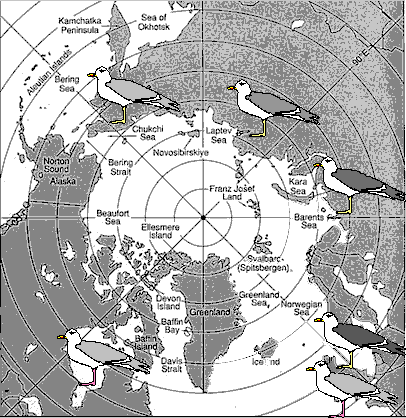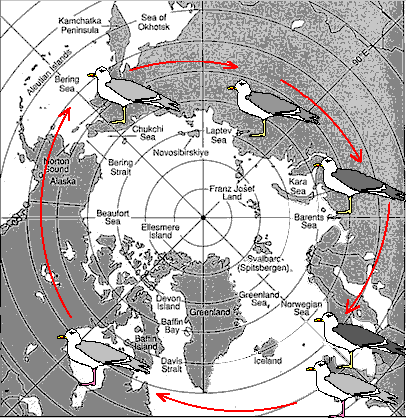There are over 9000 species of birds! Birds are easy to observe
and they have been the subject of nature studies by many of Europe's
explorers and biologists.
Some groups of birds are a fine example of a phenomenon in evolution
called a ring species. A ring species is actually a group
of related species that have evolved away from each other due
to a central barrier that restricts their mixing together thus
forcing speciation events to occur in the shape of a ring. Perhaps
an illustration will make that definition clear.
Some gulls present a ring pattern in their distribution and speciation.
In the United Kingdom we have two species of large gull (relevant
to ring speciation) -
the Herring Gull  and the Black-backed Gull
and the Black-backed Gull .
.
The Herring Gull has a grey back and pink legs while the Black-backed
Gull has a black back (well named isn't it?) and yellow legs.
North America has only the Herring Gull - the one with a grey
back and pink legs.
Siberia is home to the Vega Gull  - a species very similar to the
Herring Gull and it has the same grey back as the Herring gull
but its legs are yellow like the Black-backed Gull.
- a species very similar to the
Herring Gull and it has the same grey back as the Herring gull
but its legs are yellow like the Black-backed Gull.
|
This map shows the distribution of these gulls as well as some
others involved in the "ring".
Biard's Gull and Heuglin's Gull have slightly different degrees
of darkness on their backs and act as intermediates between the
Vega and Black-backed Gulls.
As you travel west from Siberia the gulls take on a darker back.
That is, as you move from Siberia westward (clockwise) towards
Europe the gulls start to look more like Black-backed Gulls. So
we have an almost continuos gradation of gull types.
| 
|
Although it is impossible to prove the sequence of events, a reasonable
story is that these birds evolved from a common ancestor and the
Arctic Circle acted as a ring barrier to produce these different
types of gulls.
Consider the Herring Gull (Larus argentatus) here in the
UK. Long ago it may have colonised North America. Recall that
the North American and European Herring Gull are both the same
species (Larus argentatus). The long distance caused the
"American" Herring Gulls to be isolated from the "European"
Herring Gulls. The two types of Herring Gull started to drift
apart with respect to their appearance, but only very slightly.
Nothing obvious.
When the "American" Herring Gulls colonised Siberia
they independently evolved yellow legs.
| 
|
This new leg colour probably had nothing to do with the habitat.
It was just a chance mutation that did well within the new Siberian
colony. This colony gave rise to today's Vega Gulls. Note that
Vega Gulls are still Herring Gulls (Larus argentatus) but
are so different that we call them a subspecies of the
Herring Gulls. (We'll come back to the idea of subspecies later.)
The descendants of Vega Gulls moved westward and as they did so
new mutations started to accumulate causing the populations to
diverge according to the colour (darkness) of their backs. By
the time the population made its way "back around"
to Europe the gulls had taken on a very dark back.
Here in the United Kingdom we see the "old" Herring
Gull, with its pink legs and light-coloured back, along side the
"new" Herring Gull, with its yellow legs and dark-coloured
back. Side by side they look very different. Indeed, the "old"
Herring Gull is now considered to be a separate species from the
"new" Herring Gull - which is now called
the Black-backed Gull (Larus fuscus).
Of course, scientists simply name the gulls, but what do the gulls
"think" of this?
Well, here in the UK any Black-backed Gull (Larus fuscus)
is free to mate with any Herring Gull (Larus argentatus)
but they chose not to. Apparently, Black-backed Gulls do not find
the pink legs and light-coloured back of the Herring Gulls "attractive"
enough to consider them as potential mates. So they only mate with other Black-backed Gulls.
And the Herrings Gulls limit themselves to other Herring Gulls.
This is another form of reproductive isolation but, unlike
the barrier that started the speciation, this isolation is based
upon behaviour.
So scientists and gulls agree - the Herring and Black-backed Gulls
are too different to be anything else but two separate species.
These gulls are an example of a ring species.
At most points in the ring there is only one "type"
and they differ from their neighbours only slightly. However,
where the two end points of the "speciation ring" meet (for example,
here in the UK regarding these gulls) we find two types so different
from each other they "earn" the title of separate species.
Isolation so important to speciation that is worth summarising
it here using my example. At first a physically barrier, the Arctic
Ocean, prevented the gulls from mating but by the time they had
migrated around the barrier, behavioural mechanisms had taken
over. The Arctic Ocean still acts as an effective physical barrier
between, say, American Herring Gulls and Heuglin's Gull. But,
here in the UK the Herring and Back-backed Gulls are isolated
by their own behavioural preferences.
Throughout this course you will see that isolation and the divergence
it allows is a major force in evolution.
Of course, we cannot travel back in time to see this speciation
occurring but the "story" I have just told you explains
how these two species (and the subspecies in between) may have
evolved. I (we) can only work with the data at hand so we must
create a "story" of ring speciation that is reasonable
and useful. Certainly some kind of ring speciation has occurred,
but maybe it didn't start in the UK and progress they way I have
explained (above).
|
Here's the distribution map again.
(Here's the data.)
Have a good look at it and try to imagine another "ring species
story" to explain the distribution and the speciation
Once you have thought of another scenario that would cause this
ring to form continue to the next page.
| 
|
This work was created by Dr Jamie Love  and
and  licensed under a Creative Commons Attribution-ShareAlike 4.0 International License.
licensed under a Creative Commons Attribution-ShareAlike 4.0 International License.
If you like, you can return to the Home Page.
 and the Black-backed Gull
and the Black-backed Gull .
.
 - a species very similar to the
Herring Gull and it has the same grey back as the Herring gull
but its legs are yellow like the Black-backed Gull.
- a species very similar to the
Herring Gull and it has the same grey back as the Herring gull
but its legs are yellow like the Black-backed Gull.


 and
and  licensed under a Creative Commons Attribution-ShareAlike 4.0 International License.
licensed under a Creative Commons Attribution-ShareAlike 4.0 International License.